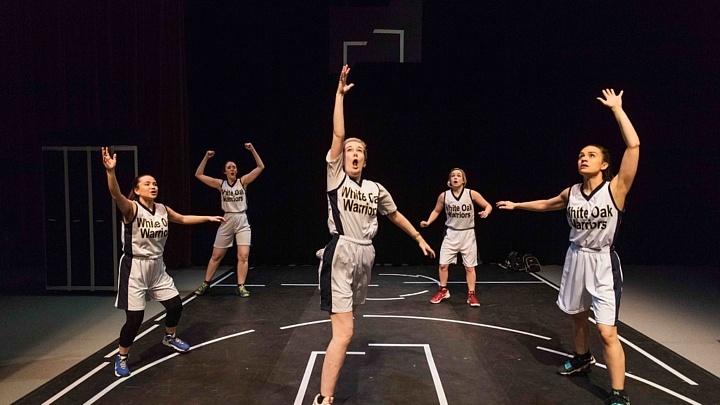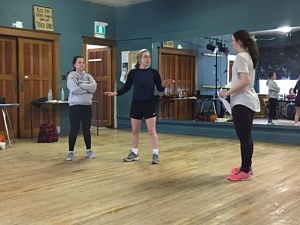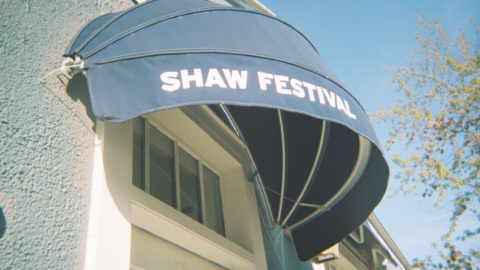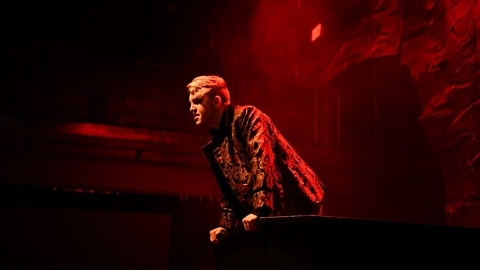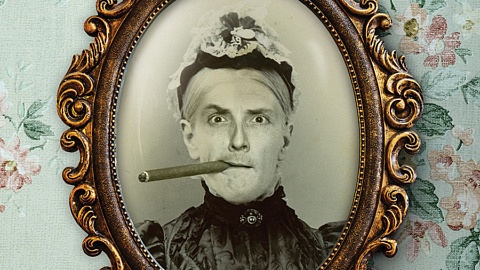Hello theatre creators, educators, scholars and everything in between! I hope you’re having a productive-yet-restful summer. Ever wonder what it’s like...
Having returned to the rehearsal room once more, half of our embedding team remarks on the changes they witness.
Hazel Adie and Frances Johnson write,
We arrive for our second and final visit to familiar smiling faces. This rehearsal is a week and a half away from Essential Collective Theatre’s first performance of The Team. Some props and set pieces have begun to be incorporated, an important element as the cast will be moving the set around themselves. This afternoon they are rehearsing the second half of the show, which we have yet to see.
The environment in this rehearsal is different than our previous visit. The material of the scenes being worked on includes a difficult confrontation between the characters Miranda, Bobbie, and Alicia. The weight of these scenes affects the atmosphere of the rehearsal room. There is still a sense of play in the actors and many laughs are shared between them; however, the emotional intensity has clearly escalated. Director Colin Anthes reminds the actors to be thinking about this change in dynamic towards the latter half of the play and to feel the emotional switches between the scenes, as these switches inform the rhythm of the performance. Even with the seriousness of the content, Anthes wants the actors to still build the camaraderie between the characters. The emotional highs and lows of each scene are important to grounding this story in the realities of teenage turmoil.

Lennon Bradford, Kaylyn Valdez-Scott, Laura Welch, Kaitlin Race, and Emily Lukasik in The Team. Photo by Lauren Garbutt Photography.
Playwright Michael Kras is present in this rehearsal as well. He is able to play a more active role than when we saw him last. During the party scene, actor Kaylyn Valdez-Scott is not sure of the intention behind one of her lines. After she and Anthes talk through the character’s objective, Kras steps in and reminds Valdez-Scott that Jess hasn’t seen Bobbie, whom she is talking to, since a previous emotionally charged scene. This is a big “A-ha” moment, not just for Valdez-Scott but for the entire room and is significantly helpful input. It is fantastic to have this kind of relationship with the writer in the rehearsal room and to be able to ask those questions directly. During the same scene, Kras is able to help the actors with the flow of their lines. He has written a lot of overlap in The Team with the exact places he wants actors to cut in with their next line marked by a forward slash in the script. There is a moment where the momentum of the scene is lost because of the actors trying to say the lines exactly as Kras had written them. Anthes and Kras decide to let the actors overlap the lines on their own time instead of following the moments indicated in the script. Having Kras in the room allows Anthes to make that decision on the spot, rather than having to wait for approval. With less focus on when the actors have to say their lines the flow of the scene is more naturalistically. After our session, Anthes mentions that he and Kras have made a handful of changes like these while working with the actors.
This point in the rehearsal process is where everything needs to be sharpened up. The actors are off-book (lines are memorized) but it is time to decide on exact delivery of lines and blocking (where the actors move on the stage in relation to each other and the set). Anthes and the actors have many different methods to help them learn and perfect the blocking. To refresh their memory the actors walk through the scene first or simply sit on the floor and read the lines aloud. As changes are being made they run the scene at fifty percent speed, then seventy percent, working on specific moments before attempting to run it at full-speed. In between each run, they discuss what worked and what did not. Anthes often stops the scene to work things through in more detail; the actors then choose a specific line of dialogue to start from, and the group works on each part until everyone is satisfied. Anthes uses the notion of repelling magnets to explain the movement, this is the dynamic he wants to see in the actors. The constant movement in this play makes blocking the scenes much like conducting traffic; Anthes and the actors take the time to work out the small details. There is a lot happening on stage when the conversations overlap and blocking often makes one of these conversations stand out by guiding the audience in where to look. Anthes notes are thoughtful rather than picky—he rarely makes a change purely for aesthetic purposes, and he makes a point to say when something works.
This is our last look at The Team until their production run. It is amazing to see this group of professionals at work. With the play already so engaging within the bare walls of a rehearsal studio, we are excited to see the final product with all its elements in place.
Related Posts
For nearly two years, theatre lovers have felt entrapped in their own little purgatories. Artists have been unable to perform on stages, and audiences been...
Frances Johnson graduated from the Department of Dramatic Arts in 2020 and was about to begin an internship at the Shaw Festival when the Covid-19 pandemic...
For nearly two years, theatre lovers have felt entrapped in their own little purgatories. Artists have been unable to perform on stages, and audiences been...
Frances Johnson graduated from the Department of Dramatic Arts in 2020 and was about to begin an internship at the Shaw Festival when the Covid-19 pandemic...
Leave a Reply (Cancel Reply)
Twitter Feed
Blogroll
DARTcritics.com is partially funded by the Marilyn I. Walker School of Fine and Performing Arts, in support of student learning; experiential education; student professionalization; public engagement with the teaching, learning and production activities of the Department of Dramatic Arts; new ways of thinking; and the nurturing of links with our communities.

